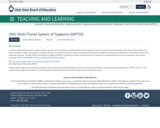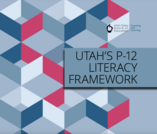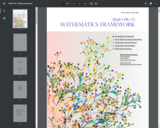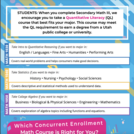
Identifying the ideal characteristics of a Utah graduate after going through the P-12 system.
- Subject:
- Professional Learning
- Material Type:
- Reading
- Provider:
- Utah State Board of Education
- Date Added:
- 08/30/2022

Identifying the ideal characteristics of a Utah graduate after going through the P-12 system.

This document contains the core standards for Physical Education k-12 for the state of Utah.

The following list has been reviewed and vetted to determine if the curricular program meets or does not meet the requirements set forth in SB 127 (2022). The review committee was only able to dive into programs that were submitted for review. The committee plans to run another review in the spring to add more programs to this list. These programs were reviewed using the Science of Reading Evidence-Informed Core Criteria Checklist. In addition, intervention programs were also reviewed using Utah’s Critical Features of Tiered Literacy Interventions document. Please note, this is not an exhaustive list and curricular programs will continue to be added as they are reviewed.

This document includes the frequently asked questions about the new ELA standards.

These slides are from the ELA standards tour of Utah and provide an overview of the new standards.

Provides districts, charters, and schools with an evidence-based framework and self-assessment tool to identify strengths and areas for growth to improve student literacy outcomes; also provides LEAs, building administrators, teachers, and other stakeholders with evidence-based practices that will yield positive literacy outcomes for students.

Utah's Kings Peak: Standard 7.NS.1 Apply and extend previous understandings of addition and subtraction to add and subtract rational numbers; represent addition and subtraction on a horizontal or vertical number line diagram.
This formative assessment exemplar was created by a team of Utah educators to be used as a resource in the classroom. It was reviewed for appropriateness by a Bias and Sensitivity/Special Education team and by state mathematics leaders. While no assessment is perfect, it is intended to be used as a formative tool that enables teachers to obtain evidence of student learning, identify assets and gaps in that learning, and adjust instruction for the two dimensions that are important for mathematical learning experiences (i.e., Standards for Mathematical Practice, Major Work of the Grade).

Technology powered learning engages students and enhances learning. Utah's Master Plan outlines how we will prepare our future workforce for the demands of a world in which everyone will be required to use and create knowledge and leverage technology as a powerful tool to aid in this
preparation.

A schoolÕs fundamental purpose is student learning. As such, some students may need extended time and support to learn critical skills and knowledge at high levels. Other students may need enrichment. A Multi-Tiered System of Support (MTSS) is a framework focused on three instructional tiers (Universal, Targeted, and Intensive) engineered to meet student needs using a systematic approach.

Utah’s K–12 Literacy Framework intends to: Provide districts, charters, and schools with an evidence-based framework and self-assessment tool to identify strengths and areas for growth to improve student literacy outcomes and provide LEAs, building administrators, teachers, and other stakeholders with evidence-based practices that will yield positive literacy outcomes for students.

The P-20 Competencies are aligned with Utah's Portrait of a Graduate and defnes the competencies into grade bands that vertically align as learners build knowledge, skills, and dispositions from Pre-K through post-secondary.

The P-20 Rubrics provide a model for creating intentional learning opportunities for students in alignment with the Utah Portrait of a Graduate. For each competency, the rubrics function as learning progressions through the continuum from Pre-K through post-secondary. The rubrics support student agency and self-assessment of their current application of knowledge and skills. The model rubrics are intended to be adapted by local communities to align with their LEA and school instruction. By having models available, the state promotes local implementation and supports access to the Utah Portrait of a Graduate for all stakeholders in PreK-12 education.

Mathematics is essential to navigating our data-filled and technologically-driven society. Every Utah learner is entitled to the acquisition of competent mathematics knowledge for skills, and dispositions and the inherent empowerment associated with such achievement. Currently, 50% of Utah’s third grade students are mathematically proficient and that percentage decreases to 43% by eighth grade (USBE, 2019). Therefore, Utah’s PK–12 Mathematics Framework is designed to serve as an evidence-based guide for educators to initiate productive growth and change in mathematical opportunities, achievement and outcomes for students in line with Utah’s Portrait of a Graduate.

Videos: Standard 8.EE.5 (Graph proportional relationships, interpreting the unit rate as the slope of the graph. Compare two different proportional relationships represented in different ways. For example, compare a distance-time graph to a distance-time equation to determine which of the two moving objects has greater speed.).
This formative assessment exemplar was created by a team of Utah educators to be used as a resource in the classroom. It was reviewed for appropriateness by a Bias and Sensitivity/Special Education team and by state mathematics leaders. While no assessment is perfect, it is intended to be used as a formative tool that enables teachers to obtain evidence of student learning, identify assets and gaps in that learning, and adjust instruction for the two dimensions that are important for mathematical learning experiences (i.e., Standards for Mathematical Practice, Major Work of the Grade).

This microcredential represents a teacher’s understanding of visualization, composition, and decomposition of geometric shapes and their ability to understand and respond to progressions related to these concepts by planning and implementing instruction based on the Standards for Mathematical Practice and Effective Mathematics Teaching Practices. It involves selecting, using, and adapting mathematics curricula and teaching materials, including the integration of mathematical tools and technology, as well as using and analyzing formative and summative assessments to determine students' understanding of visualization, composition, and decomposition of geometric shapes. This is the first of five Microcredentials in the Elementary Mathematics Endorsement: Geometry, Measurement, and Data Stack. These Microcredentials can be earned in any order.

Volleyball Bake Sale: Standard 8.F.1.Understand that a function is a rule that assigns to each input exactly one output. The graph of a function is the set of ordered pairs consisting of an input and the corresponding output. (Function notation is not required in grade 8.)
This formative assessment exemplar was created by a team of Utah educators to be used as a resource in the classroom. It was reviewed for appropriateness by a Bias and Sensitivity/Special Education team and by state mathematics leaders. While no assessment is perfect, it is intended to be used as a formative tool that enables teachers to obtain evidence of student learning, identify assets and gaps in that learning, and adjust instruction for the two dimensions that are important for mathematical learning experiences (i.e., Standards for Mathematical Practice, Major Work of the Grade).

What Are the Odds?: Standard 7.SP.8 Find probabilities of compound events using organized lists, tables, tree diagrams, and simulation.
This formative assessment exemplar was created by a team of Utah educators to be used as a resource in the classroom. It was reviewed for appropriateness by a Bias and Sensitivity/Special Education team and by state mathematics leaders. While no assessment is perfect, it is intended to be used as a formative tool that enables teachers to obtain evidence of student learning, identify assets and gaps in that learning, and adjust instruction for the two dimensions that are important for mathematical learning experiences (i.e., Standards for Mathematical Practice, Major Work of the Grade).

Which Concurrent Enrollment Math Course is Right for You?

Who Wants to Fish?: Standard 7.EE.4 (Use variables to represent quantities in real-world or mathematical problems and construct simple equations and inequalities to solve problems by reasoning about the quantities. a) Solve word problems leading to equations of the form px + q = r and p(x + q) = r, where p, q, and r are specific rational numbers. b) Solve word problems leading to inequalities of the form px + q > r or px + q < r, where p, q, and r are specific rational numbers.
This formative assessment exemplar was created by a team of Utah educators to be used as a resource in the classroom. It was reviewed for appropriateness by a Bias and Sensitivity/Special Education team and by state mathematics leaders. While no assessment is perfect, it is intended to be used as a formative tool that enables teachers to obtain evidence of student learning, identify assets and gaps in that learning, and adjust instruction for the two dimensions that are important for mathematical learning experiences (i.e., Standards for Mathematical Practice, Major Work of the Grade).

Why Be Rational?: Standard 8.NS.2 - Use rational approximations of irrational numbers to compare the size of irrational numbers, locate them approximately on a number line diagram, and estimate the value of expressions (e.g., π2). For example, by truncating the decimal expansion of √2, show that √2 is between 1 and 2, then between 1.4 and 1.5, and explain how to continue on to get better approximations.
This formative assessment exemplar was created by a team of Utah educators to be used as a resource in the classroom. It was reviewed for appropriateness by a Bias and Sensitivity/Special Education team and by state mathematics leaders. While no assessment is perfect, it is intended to be used as a formative tool that enables teachers to obtain evidence of student learning, identify assets and gaps in that learning, and adjust instruction for the two dimensions that are important for mathematical learning experiences (i.e., Standards for Mathematical Practice, Major Work of the Grade).